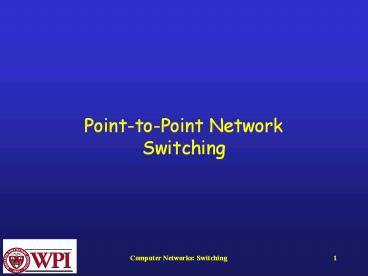Point-to-Point Network Switching - PowerPoint PPT Presentation
Title:
Point-to-Point Network Switching
Description:
A setup stage is used to determine the end-to-end path before a connection is established. ... No set up is needed. Each packet contains information which ... – PowerPoint PPT presentation
Number of Views:36
Avg rating:3.0/5.0
Title: Point-to-Point Network Switching
1
Point-to-Point NetworkSwitching
2
Point-to-Point Network Switching
- Circuit Switching, Message Switching, Packet
Switching, Cell Switching - Connection-Oriented versus Connectionless
- Virtual Circuit versus Datagram Networks
- Internal/External Abstractions
3
Point-to-Point Switching
- Circuit Switching
- Store-and -Forward Networks
- Message Switching
- Packet Switching
- connection-oriented vs connectionless
- virtual circuit vs datagram
- Cell Switching
4
Circuit Switching
- Seeking out and establishing a physical copper
path from end-to-end historic definition . - Circuit switching implies the need to first set
up a dedicated, end-to-end path for the
connection before the information transfer takes
place. - Once the connection is made the only delay is
propagation time.
5
Circuit Switching
- Figure 2-38. (a) Circuit switching. (b) Packet
switching.
Tanenbaum slide
6
Store-and-Forward Networks
- Intermediate processors (IMPS, nodes, routers,
gateways, switches) along the path store the
incoming block of data. - Each block is received in its entirety, inspected
for errors, and retransmitted along the path to
the destination. This implies buffering at the
router and one transmission time per hop.
7
Message Switching
- A store-and-forward network where the block of
transfer is a complete message. - Since messages can be quite large, this can
cause - buffering problems
- high mean delay times
8
Packet Switching
- A store-and-forward network where the block of
transfer is a complete packet. A packet is a
variable length block of data with a tight upper
bound. - Using packets improves mean message delay.
9
Cell Switching
53 bytes
- A network where the unit of transfer is a small,
fixed-size block of date (i.e., one cell). - ATM (Asynchronous Transfer Mode) networks use
53-byte cells.
10
Packet Switched Networks
- Connection-oriented Protocols
- A setup stage is used to determine the end-to-end
path before a connection is established. - Data flow streams are identified by some type of
connection indicator (e.g. OSI, X.25, SNA).
11
Connection-Oriented Concatenation of Virtual
Circuits
- Figure 5-45.Internetworking using concatenated
virtual circuits.
Tanenbaum slide
12
Packet Switched Networks
- Connectionless Protocols
- No set up is needed.
- Each packet contains information which allows the
packet to be individually routed hop-by-hop
through the network.
13
Connectionless Internetworking
- Figure 5-46. A connectionless internet.
Tanenbaum slide
14
Datagram vs Virtual Circuit
- Datagram
- Each datagram packet may be individually routed.
- Virtual Circuit
- Virtual circuit set up is required.
- All packets in a virtual circuit follow the same
path.
15
Event Timing
DCC 6th Ed., W. Stallings, Figure 10.3
16
- External
- Virtual Circuit
- And Datagram
- Operation
- DCC 6th Ed.,
- W. Stallings,
- Figure 10.4
17
- Internal
- Virtual Circuit
- And Datagram
- Operation
- DCC 6th Ed.,
- W. Stallings,
- Figure 10.5































